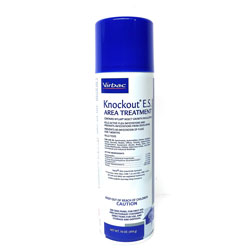Knockout ES Area Treatment Aerosolized Can
+ Save on each recurring order!
- Prevents reinfestation for seven months
- kills active flea infestations and ticks
- Treats up to 2100 sq. ft.
- Can only be shipped UPS Ground Only
Description
Virbac Knockout E.S. Area Treatment is an inverted aerosol spray designed for use in the home containing pyrethrins and permethrin to kill active flea infestations and ticks. Also contains pyriproxyfen Nylar insect growth regulator to prevent flea infestations from developing for up to 7 months. One 16 oz. can covers approximately 2100 square feet.
Benefits
- Prevents re-infestation for seven months
- kills active flea infestations and ticks
- Treats up to 2100 sq. ft.
- PRECAUTIONARY STATEMENTS
To Control Ticks and Fleas
Old bedding should be removed and replaced with fresh, clean bedding after treatment.
Pets should be treated with a registered product for flea and tick control in conjunction with this product.
EXCEPT FOR APPLICATOR, DO NOT PERMIT HUMANS OR PETS TO CONTACT TREATED SURFACES UNTIL THE SPRAY HAS DRIED. DO NOT TREAT PETS WITH THIS PRODUCT.
For Use In And Around
Apartments, automobiles, homes, hospitals, hotels, kennels, motels, offices, schools, supermarkets, transportation equipment (buses, boats, ships, trains, trucks), warehouses, utilities, veterinary clinics and other commercial and industrial buildings.
Notice
KNOCKOUT E.S. Area Treatment has been tested on several types of carpet, fabric and other household furnishings without adverse effects. In a few instances, waxed surfaces have been whitened or dulled. Holding the can 36 inches away from the target surface normally prevents any whitening from occurring. Because of the wide variety of floor types and finishes, treat a small inconspicuous area before treating the entire area. Avoid contact with antique finishes.
Instructions
Use KNOCKOUT E.S. Area Treatment at the rate of 16 oz. for up to 2100 sq. ft. (8 oz. for up to 1050 sq. ft.).
Carpeted areas may be vacuumed before treatment and after treatment has dried.
Treat infested areas or areas which could be infested; these include rugs, carpets, upholstered furniture, pet beds and pet resting areas.
- Hold can at arm’s length and direct spray toward the area to be treated.
- Use a sweeping motion to apply product and back away from treated area while holding the can 36 inches away from the surface being treated.
Area of 80-100 sq. ft. can be treated in approximately 10 seconds with KNOCKOUT E.S.Area Treatment.
When treating upholstered furniture, treat under cushions and areas where flea development occurs. Cover aquariums and fish bowls and remove birds from area prior to treating. Treated areas should be vacated during application.
Active Ingredients
| Pyriproxyfen | 0.100% |
| Pyrethrins | 0.050% |
| n-Octyl bicycloheptene dicarboximide* | 0.400% |
| Permethrin | 0.400% |
| Related Compounds | 0.035% |
| Other Ingredients | 99.015% |
| TOTAL | 100.000% |
Environmental Hazards
This product is toxic to fish and birds. Do not apply directly to water or to areas where surface water is p
resent or to intertidal areas below the mean high water mark. Drift from treated areas may be hazardous to organisms in adjacent aquatic sites. Apply this product only as specified on the label.
Physical or Chemical Hazards
Extremely Flammable. Contents under pressure. Keep away from fire, sparks, and heated surfaces. Do not puncture or incinerate container. Exposure to temperatures above 130°F may cause bursting.
Storage and Disposal
Do not contaminate water, food or feed by storage or disposal.
Store in a cool dry place away from heat or open flame and inaccessible to children.
Pesticide Disposal
Wastes resulting from use of this product may be disposed of on site or at an approved waste disposal facility.
Container Disposal
Do not puncture or incinerate! Empty container by using the product according to the label directions. Offer empty container for recycling, if available, or place in trash if allowed by state and local regulations. If container is partly filled, contact your local waste agency for disposal instructions.
Caution
First Aid
If Swallowed
Immediately call a Poison Control Center or doctor. Do not induce vomiting unless told to do so by a Poison Control Center or doctor. Do not give ANY liquid to the person. Do not give anything by mouth to an unconscious person.
If in Eyes
Hold eyes open and rinse slowly and gently with water for 15-20 minutes. Remove contact lenses, if present, after the first 5 minutes, then continue rinsing eyes. Call a Poison Control Center or doctor for treatment advice.
If on Skin or Clothing
Take off contaminated clothing. Rinse skin immediately with plenty of water for 15-20 minutes. Call a Poison Control Center or doctor for treatment advice.
If Inhaled
Move person to fresh air. If person is not breathing, call 911 or an ambulance, then give artificial respiration, preferably mouth-to-mouth, if possible. Call a Poison Control Center or doctor for treatment advice.







